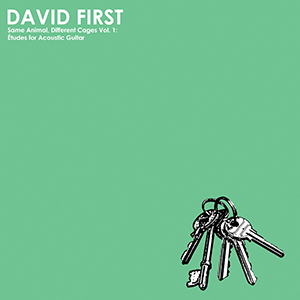 David First has been active as a composer for a multitude of years, never allowing his work to draw too heavily from just one style or technique. Many of his pieces feature elements of everything from folk to noise to classical drone, and almost everything in between. Because of that, the self-imposed limitations of the four part Same Animal, Different Cages adds additional depth by stripping much away. Etudes for Acoustic Guitar is exactly as its title implies: 12 performances utilizing only a Guild D-40 acoustic guitar, and the final product is diverse, compelling, and at times challenging, but a resounding success.
David First has been active as a composer for a multitude of years, never allowing his work to draw too heavily from just one style or technique. Many of his pieces feature elements of everything from folk to noise to classical drone, and almost everything in between. Because of that, the self-imposed limitations of the four part Same Animal, Different Cages adds additional depth by stripping much away. Etudes for Acoustic Guitar is exactly as its title implies: 12 performances utilizing only a Guild D-40 acoustic guitar, and the final product is diverse, compelling, and at times challenging, but a resounding success.
The expected styles we in the Western world associate with First's instrument of choice can be heard throughout this record, unsurprisingly.Folksy strumming and country twangs appear throughout "Etude #4" and "Etude #7", respectively.However, it is First's approach to creating these overly familiar sounds that makes this record what it is.On the former, he applies just enough pitch bends (I assume by adjusting string tension) to result in an uneasy, "not right" feeling, defying what is expected of regarding tone and tuning.For "Etude #7", he applies the twang effect to an almost comical extreme, resulting in a cartoon-like "boing" spring sound that adds a bit of playfulness to the piece.
"Etude #15" features a blues like progression that, again, with his unconventional approach to pitch and tone results in a very unique sound due to its inherent off-kilter-ness.First is happy to defy expectations many times on this record, which is a significant asset.Scattered throughout the album as a whole are sitar-like tones and frequencies that present a definitively Eastern influence to the otherwise Western-centric instrument and overall sound.
The most fascinating moments are the ones in which his background as a minimalist composer (in the classical sense) shines through the most."Etude #17" is full of cyclic playing and bits of improvised percussion, blending guitar plucks and strums into hypnotically repetitive motifs.Appropriately, however, he changes up the tempo a few times with brilliantly jarring effect.For "Etude #5", First locks his playing into a buzzing, insistent throb that does not relent.The psycho-acoustic properties of this cause the sound to resemble anything but a guitar, and the buzzing of the strings themselves seems to become a different instrument.The final "Etude #31" comes from a similar compositional tactic, and by the end it sounds more like a pulsing synthesizer than a mere acoustic guitar.
Throughout Etudes for Acoustic Guitar, David First works in some clear bits of playfulness and at times difficult moments of sound.His use of the tuning pegs to bend the pitches of strings results in an occasionally uncomfortable edge, and his intentional shifting of rhythms and tempos mid-performance leads to things sounding a bit "off" at times.However, it is for these reasons that the album shines, being a rather unique, creative take on such a ubiquitous instrument.The remaining three "cages" he has chosen to lock himself into for the remainder of the series (synthesizer, harmonica, and sitar) are a diverse enough array that, given his idiosyncratic approach, should make for three more excellent records.
samples:
 
Read More

